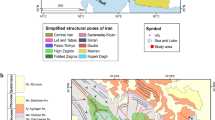Abstract
Clay-bearing rocks are characterized by a wide variation in engineering properties and their resistance to short term weathering due to wetting and drying phenomenon. In this study, a research study was performed on different clay-bearing rocks selected from the Ilam and the Tajarak regions (Iran) to assess suitability of the static and dynamic standard slaking tests. Also in this paper, in order to estimate durability of the clay-bearing rocks, some physical–chemical properties were used in form of multiple linear regression analyses in relation to the static and dynamic slaking indices. The test results from the static and dynamic standard slaking tests showed that the materials retained in the 2 mm mesh drum consists of disintegrated particles varying in diameter from 2 to 25.4 mm. To achieve a more realistic evaluation of the disintegration properties of rock samples after each wetting–drying cycle, a sieve analysis approach is therefore more appropriate. Comparison of the multiple linear regressions between the slaking indices and physical–chemical properties showed that the disintegration ratio could characterize the durability behavior of the rock samples in both the static and dynamic states. Also, the results indicated that the static slaking index (Is) was more acceptable for predicting the behavior of clay-bearing rocks than the dynamic durability index (Id).








Similar content being viewed by others
References
ASTM D5313–12 (2013) standard test method for evaluation of durability of rock for erosion control under wetting and drying conditions
ASTM D 4318 (2004a) standard test method for liquid limit, and plasticity index of soils
ASTM D 4373-14 (2004b) standard test method for rapid determination of carbonate content of soils
ASTM D 4644-04 (2004c) standard test method for slake durability of shales and similar weak rocks
Deo P (1972) Shales as embankment materials, Ph. D. Thesis, Purdue University
Dick JC, Shakoor A, Wells N (1994) Geological approach toward developing a mudrock durability classification system. Can Geotech J 31(1):17–27
Erguler ZA (2007) Investigation of the effect of water content on engineering behavior of the clay-bearing rocks. PhD Thesis, Hacettepe University, Geological Engineering Department (in Turkish)
Erguler ZA, Shakoor A (2009) Relative contribution of various climatic processes in disintegration of clay-bearing rocks. Eng Geol 108:36–42
Erguler ZA, Ulusay R (2009) Assessment of physical disintegration characteristics of clay-bearing rocks: disintegration index test and a new durability classification chart. Eng Geol 105:11–19
Franklin JA, Chandra A (1972) The slake-durability test. Int J Rock Mech Min Sci 9:325–341
Fuenkajorn K (2011) Experimental assessment of long-term durability of some weak rocks. Bull Eng Geol Environ 70:203–211
Gamble JC (1971) Durability–plasticity classification of shales and other argillaceous rocks. Ph.D. Thesis, University of Illinois, Urabana
Gokceoglu C (1997) The approaches to overcome the difficulties encountered in the engineering classification of clay-bearing, densely jointed and weak rock masses. PhD Thesis, Hacettepe University, Geological Engineering Department (in Turkish)
Gokceoglu C, Ulusay R, Sonmez H (2000) Factors affecting the durability of selected weak and clay-bearing rocks from Turkey, with particular emphasis on the influence of the number of drying and wetting cycles. Eng Geol 57:215–237
IBM SPSS (2012) Statistical package for the social sciences. Data analysis software packages. Version 21. SPSS Inc., Chicago
Ichinose M, Matsui K (1989) Water-durability of coal measure rocks. J Soil Found 37–4(375):43–47
ISRM (1979) Suggested method for determination of the slake durability index. Int J Rock Mech Min Sci Geomech Abstr 16:154–156
ISRM (2007) The complete ISRM suggested methods for rock characterization, testing and monitoring: 1974–2006. In: Ulusay R, Hudson JA (eds) Suggested methods prepared by the commission on testing methods. International society for rock mechanics, Ankara
Karakus M, Kumral M, Kilic O (2005) Predicting elastic properties of intact rocks from index tests using multiple regression modeling. Int J Rock Mech Min Sci 42:323–330
Koncagul EC, Santi PM (1999) Predicting the unconfined compressive strength of the Breathitt shale using slake durability, Shore hardness and rock structural properties. Int J Rock Mech Min Sci 36(2):139–153
Moon VG, Beattie AG (1995) Textural and micro structural influence on the durability of Waikato coal measures mud rocks. Q J Eng Geol 28:303–312
Morgenstern NR, Eigenbrod KD (1974) Classification of argillaceous soils and rocks. J Geotech Eng Div 100:1137–1156
Moriwaki Y, Mitchell JK (1977) The role of dispersion in the slaking of intact clay. In: Sherard JL, Decker RS (eds) Dispersive clays, related piping, and erosion in geotechnical projects. ASTM STP 623: American Society for Testing and Materials, Philadelphia, pp 287–302
Sadisun IA, Shimada H, Ichinose M, Matsui K (2002) Evaluation of physical deterioration of slake-prone rock subjected to static slaking test. The 11th Japan national symposium for rock mechanics, Chiba, Japan
Sadisun IA, Shimada H, Ichinose M, Matsui K (2005) Study on the physical disintegration characteristics of Subang claystone subjected to a modified slaking index test. Geotech Geol Eng 23:199–218
Santi PM, Koncagul EC (1996) Predicting the mode, susceptibility, and rete of weathering of shale. American Society of Civil Engineers, New York, pp 37–55
Sebastian Brysona L, Gomez Gutierreza IC, Hopkinsb TC (2012) Development of a new durability index for compacted shale. Eng Geol 139–140:66–75
Taylor RK (1988) Coal measures mudrocks: composition, classification and weathering processes. Q J Eng Geol 21:85–99
Venter JP (1981) Free swell properties or some South African mudrocks. In: Proceedings of international symposium on weak rock, vol 1. Balkema, Amsterdam, pp 233–242
Wood LE, Deo P (1975) A suggested system for classifying shale materials for embankment. Bull Assoc Eng Geol 12(1):39–55
Author information
Authors and Affiliations
Corresponding author
Rights and permissions
About this article
Cite this article
Heidari, M., Rafiei, B., Mohebbi, Y. et al. Assessing the Behavior of Clay-Bearing Rocks Using Static and Dynamic Slaking Indices. Geotech Geol Eng 33, 1017–1030 (2015). https://doi.org/10.1007/s10706-015-9884-6
Received:
Accepted:
Published:
Issue Date:
DOI: https://doi.org/10.1007/s10706-015-9884-6




